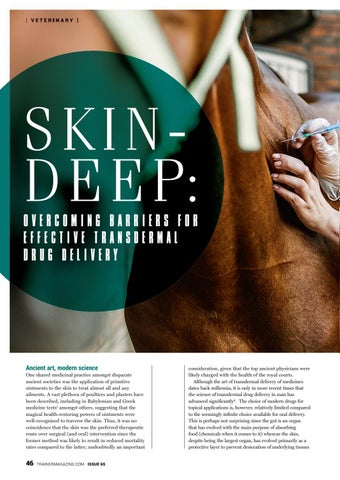| VETERINARY |
SK I ND E E P: OVERCOMING BARRIERS FOR EFFECTIVE TRANSDERMAL D R U G D E L I V E RY
Ancient art, modern science
One shared medicinal practice amongst disparate ancient societies was the application of primitive ointments to the skin to treat almost all and any ailments. A vast plethora of poultices and plasters have been described, including in Babylonian and Greek medicine texts1 amongst others, suggesting that the magical health-restoring powers of ointments were well-recognised to traverse the skin. Thus, it was no coincidence that the skin was the preferred therapeutic route over surgical (and oral) intervention since the former method was likely to result in reduced mortality rates compared to the latter; undoubtedly an important
46
TRAINERMAGAZINE.COM ISSUE 65
consideration, given that the top ancient physicians were likely charged with the health of the royal courts. Although the art of transdermal delivery of medicines dates back millennia, it is only in more recent times that the science of transdermal drug delivery in man has advanced significantly2. The choice of modern drugs for topical applications is, however, relatively limited compared to the seemingly infinite choice available for oral delivery. This is perhaps not surprising since the gut is an organ that has evolved with the main purpose of absorbing food (chemicals when it comes to it) whereas the skin, despite being the largest organ, has evolved primarily as a protective layer to prevent desiccation of underlying tissues
